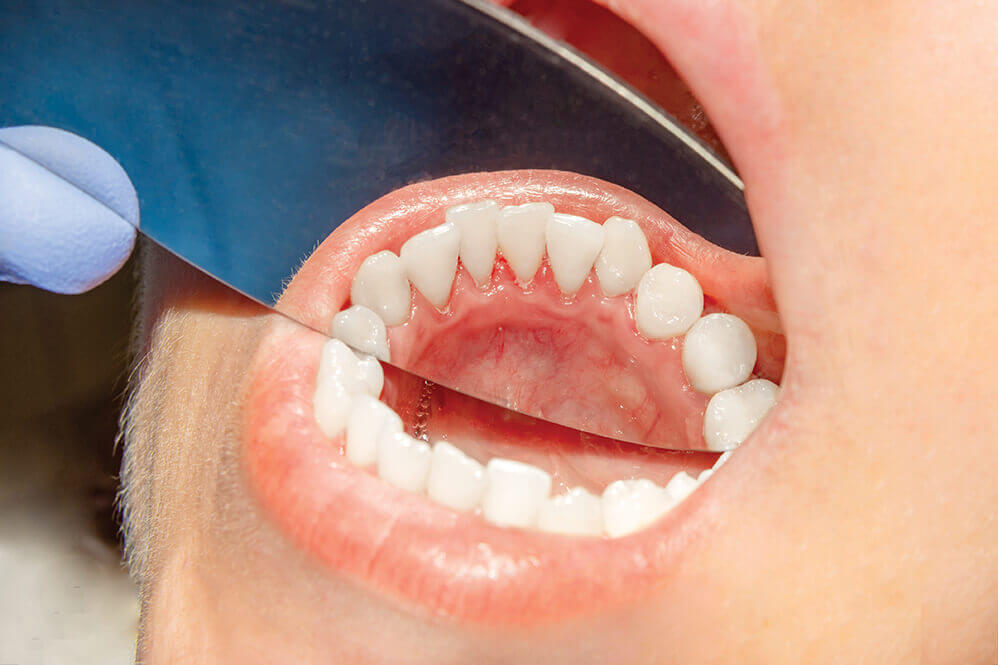Oral Cancer
Oral cancers appear as red or white patches of mouth tissue or small ulcers that look like a canker sores, but are painless. Oral cancers usually form on the tongue or floor of the mouth, but can occur on any tissue in and around the mouth. This includes cancers of the tonsils, adenoids, uvula (soft palate), roof of the mouth (hard palate), inside the lining of the cheeks, the gums, teeth, lips, the area behind the wisdom teeth and salivary glands. Some of these lesions may be benign, others may be malignant, and still others are precancerous. The most common type of precancerous cells in the mouth are:

- Leukoplakias: Leukoplakias consist of thick, white lesions that most commonly form beneath or around the tongue, cheeks or gums. These mouth sores are most often seen in tobacco users.
- Erythroplakias: These lesions appear as a red, raised area in the mouth and have a higher incidence of becoming malignant.
- A biopsy is often needed to diagnose leukoplakias and erythroplakias.
Squamous cell carcinomas are the most common type of oral cancer. Less common are lymphoma and salivery gland cancers. Most oral cancers occur in people age 45 and older. When cancers of the mouth do metastasize, they are most likely to spread to the lymph nodes in the neck.
If you have a mouth sore that won’t heal, please contact our office and schedule an appointment with one of our otolaryngologists.

Mouth Sores
There are a variety of sores that can occur in or around the mouth. Most are benign, but some may be indicative of cancer.
Canker Sores
These small, creamy white ulcers have a red border and always appear inside the mouth. Canker sores can be painful, but they are not contagious. They usually heal in one-to-two weeks. Prescription drugs and over-the-counter topical treatments can help reduce the pain.
Cold Sores
Also known as fever blisters, cold sores are fluid-filled blisters that form on the lips or around the mouth. Cold sores are usually caused by the herpes simplex virus, and are both contagious and painful. Fever, sunburn, trauma, hormonal changes or emotional upset can trigger their appearance. While there is currently no cure, cold sores can be treated with prescription ointments to help alleviate the pain. It is also important to wash your hands frequently and avoid sharing personal products to help prevent the spread of the infection to other people.
Candidiasis
Also known as oral thrush, this mouth sore is caused by a fungal infection. Painful red and cream-colored patches form on moist areas of the mouth. Candidiasis can cause difficulties with swallowing and taste. It is most commonly seen by denture wearers or people who have problems with their immune systems. Sometimes it occurs as a result of an unrelated antibiotic treatment, which can decrease normal bacterial development in the mouth. Saliva substitutes and antifungal creams are used to treat candidiasis.
White Patches
Chronic irritations inside the mouth, such as cheek chewing, dentures or braces, sometimes cause benign white patches to form inside the mouth. The treatment is to alleviate the irritation to allow for natural healing.
Leukoplakias
Leukoplakias consist of thick, white lesions that most commonly form beneath or around the tongue, cheeks or gums. Leukoplakias are painless, but can become cancerous over time. These mouth sores are most often seen in tobacco users. A biopsy may be needed to accurately diagnose leukoplakias.
Sore Throat
Everyone experiences sore throats when they have a cold or flu. But there are other reasons for sore throats that may be symptomatic of more serious problems.

Strep Throat
Strep throat is caused by streptococcal bacteria (strep) in the throat and often the tonsils. Symptoms include sudden severe sore throat, pain swallowing, a fever over 101 degrees, swollen tonsils and lymph nodes, and white or yellow spots on a reddened back of the throat. Strep throat is highly contagious, with a two-to-five day incubation period. It can be diagnosed through a physical examination and a throat culture. Strep throat is treated with antibiotics and usually resolves in three to seven days, although the healing time can be up to two weeks. It is important to have strep throat diagnosed and begin treatment as soon as possible in order to prevent its spread to others.
Inflamed Tonsils and Adenoids
Tonsillitis is an inflammation of the tonsils located in the back of the throat on both sides of the tongue. Tonsils are part of the body’s natural immune system. This tissue captures bacteria and viruses to either prevent them from entering the body or trigger the appropriate immune response. The back of the throat may appear red or swollen or have a white or yellow coating covering the tonsils. The adenoids (tissue high in the throat behind the nose and soft palate) may also be inflamed and swollen, impeding swallowing and/or breathing. Symptoms include a severe sore throat, painful or difficult swallowing, coughing, headache, fever, chills and swelling of the cheeks and neck. Tonsillitis may also be caused by strep throat. Antibiotic medication is generally prescribed to treat the inflammation. Tonsillitis usually resolves in four to seven days if caused by a virus. Chronic cases of repeated tonsillitis may require surgical removal of the tonsils and/or adenoids (tonsillectomy and adenoidectomy). An adenoidectomy may also be recommended for children experiencing chronic ear infections.
Laryngitis
The larynx allows air to pass in and out of the lungs while preventing solids (food) and liquids from entering the lungs. The larynx also contributes to sound production by the vocal cords. Laryngitis is an inflammation of the larynx, the top portion of the windpipe (trachea). It is characterized by hoarseness, coughing, difficulty in breathing for some children and, occasionally, loss of voice. In addition to an infection, laryngitis may be caused by acid reflux or nodules, polyps or nerve damage on the vocal cords. Laryngitis usually heals by itself within two weeks with the help of increased air moisture, drinking plenty of fluids and resting the voice.
Pharyngitis
The pharynx is tissue that resides behind the mouth an soft palate and acts as a pathway for food and liquids to enter the esophagus and air to enter the lungs. An inflammation of the pharynx is called pharyngitis. Painful swallowing is the most common symptom. Pharyngitis may also occur along with laryngitis. Again, the inflammation usually heals by itself with rest, fluids and air humidity.
Epiglottitis
The epiglottis is a flap of tissue at the base of the tongue that keeps food from going into the windpipe when swallowing. Epiglottitis occurs when this tissue becomes inflamed and infected. The swelling of the epiglottis can block the tongue and result in a medical emergency. In addition to infections, epiglottitis can be caused by chemicals (illicit drugs), severe heat damage (thermal epiglottitis) or trauma. If you experience a sore throat that hampers your ability to swallow, seek immediate medical attention.
If you have a sore throat that causes pain or won’t heal, please contact our office and schedule an appointment with one of our otolaryngologists.










